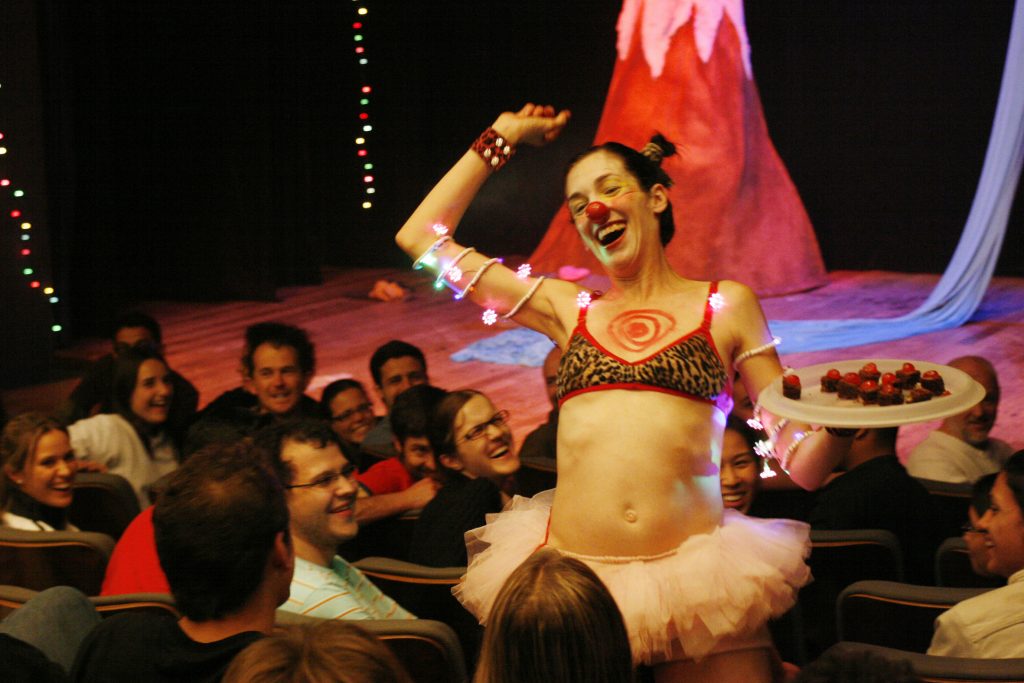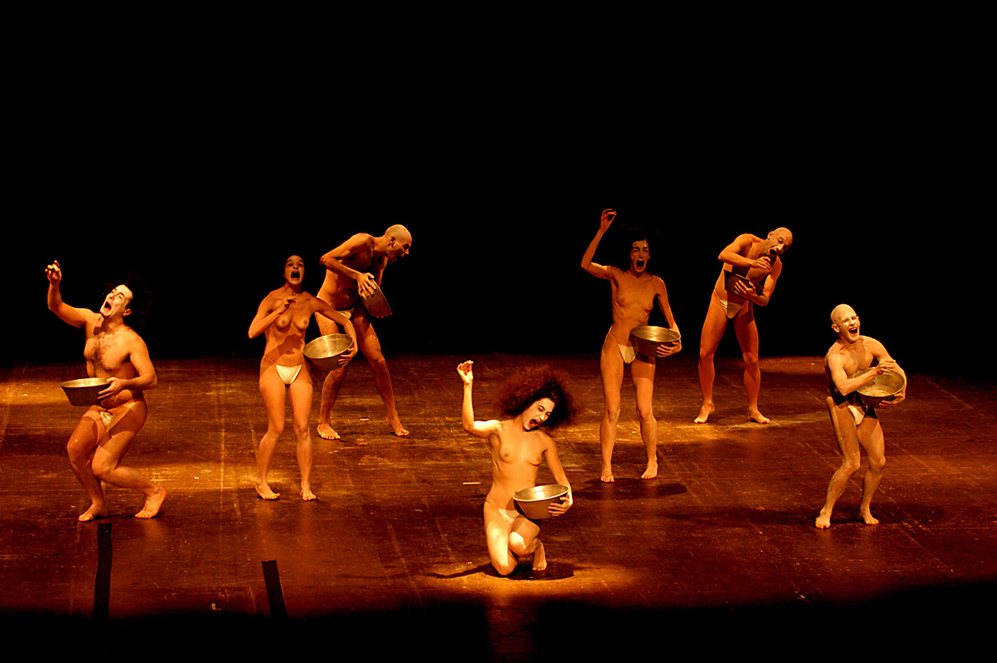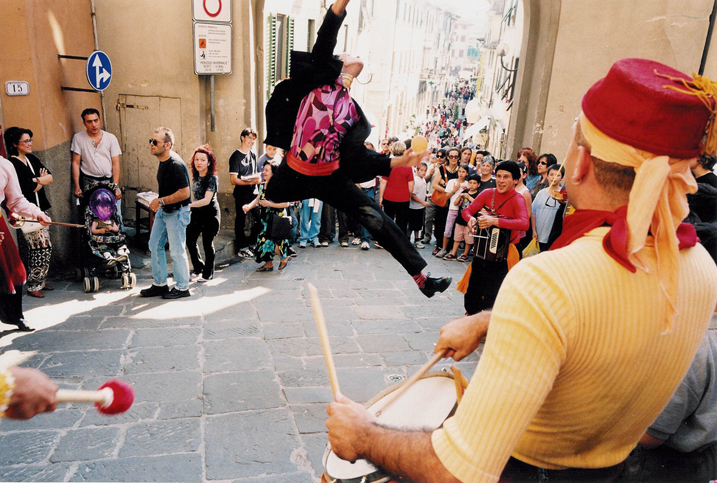Naomi Silman, longstanding member of Brazil’s Lume Teatro, reflects on her experiences of artistic exchange with the indigenous Brazilian Kariri Xoco tribe – a process of bridge building, and making the invisible visible
‘We can transform an energy that is heavy and make it light… In the moment of our ritual, as we shake our arms, we shake the heart of mother earth, and she shakes up all the peoples who live within her… and the example of this is us today, all mixed together playing, singing, dancing, smoking pawi, smiling, exchanging, helping each other… What Brazil needs, what the world needs, is to be together.’ – Pawana Crody, spiritual and cultural leader, Kariri Xoco tribe, Brazil
2017. We are stood in a circle on the ‘patio’, an irregular, broken concrete rectangle surrounded by luscious green plants and giant, gnarled trees – remnants of the almost extinct Atlantic Rainforest. ‘We’ are our special guests, the Kariri Xocos, who have come all the way from their village on the margins of the River São Francisco in Alagoas, North East Brazil; and us, the local clowns and musicians from the Campinas/São Paulo region, South East Brazil.
The Kariri Xocos draw compulsively on their pawi – sacred pipe – and spit the excess saliva from their mouths onto the ground, symbolising the continuous cycle involving the four elements – earth (the pipe crafted from wood), fire (burning the tobacco), air (exhaling the smoke), and water (spitting of the saliva, which is in turn returned to the earth).
It is a large circle and just being there all together sharing this common goal feels special. Standing next to our indigenous guests underlines our privilege, with all the material comfort and options available to us as members of the dominant, western culture. But when their leader Pawana starts to speak, weaving a tapestry of words about their connection and respect for the natural world (plants, trees, animals, invisible beings), their beliefs, their rituals, their songs and their dances, it is we that feel impoverished and eagerly soak up every word and gesture he and his ‘brothers’ have to share with us.

Will I manage to convey more than just ‘how exotic these people are?’, a bite-sized indigenous cultural tourist visit? The profound impact of meeting something ‘foreign’ to our familiar culture, but that if we remain open to this otherness and stay aware of our own cultural baggage and preconceptions we can begin a dialogue that is transforming. Isn’t this why I’ve spent 30 years in theatre practice? Except now I am faced with trying to put this into the ‘right’ words. Words that I have spent the same amount of time trying to avoid by investigating to exhaustion other means of expression. Words in English, my mother tongue, which I have rarely spoken in 25 years of living in Portuguese-speaking Brazil. I feel tense and challenged.
We are here at the Casarão Cultural Centre to prepare for our upcoming Cabaré do Povo Parrir e Pacantar (People for Laughter and Singing Cabaret). The ‘Kariris’ (as we refer to them) find it curious and amusing that we artists insist on something we call ‘rehearsal’. This is a foreign concept to them since, as they put it, ‘either we do it for real, or not at all’. Our ‘rehearsal’ transforms into a vibrant exchange about how to intertwine the scenes and clown gags from our repertoires with the Kariri’s ritual songs and dances that we had experienced a year earlier, as well as imparting to us more of the meaning and function of these rituals within the tribe. Interestingly, Pawana points out that within their tradition they do not have someone who embodies the clown or comic persona – instead they have certain dances and songs through which they evoke the ‘spirit of laughter’ which then ‘visits’ all members of the community. Drawing these parallels – I like to think of them as bridges – bring us closer together, despite our different experiences.

Rewind to 2016. The first edition of our joint cabaret. Kariris, clowns and musicians occupy separate slots in the variety programme, each of us presenting within our own artistic language with minimal moments of interaction between us. The last number of the evening: three of the clowns dressed as doctors try to resuscitate their patient – a bleeding and bandaged inflatable plastic globe – until its heartbeat returns. We then all come back on stage and in a symbolic gesture the revived globe is presented to the Kariri leader, Pawana. Even though ‘improvisation’ is also a foreign concept to the Kariris, Pawana immediately seizes the moment and clasping the globe delivers a poignant speech about his – and other indigenous peoples’ – fight for their land. His final words impact upon us all:
‘In this difficult struggle, joy is one of our biggest allies. It gives us strength to continue fighting. Which is why the clowns are so important, bringing to our village this most precious weapon. Because my cure can be in you and your cure can be in me.’
Other questions were – and still are – rapidly surfacing in me. What is my art for? Why do I do it? Of course, not only to entertain, but also to touch the audience with a meaningful experience. And yet here I was on stage amongst a people whose very survival was in question. Invisible people. Ever since the invasion, or as it is called ‘colonisation’ of Brazil, the country’s indigenous people have been massacred; their land invaded and leased; their way of life, languages and culture practically erased. Despite the recent legal process of demarcation of land to guarantee the rights of the surviving indigenous communities, much of it remains, until the present time, occupied by farmers, protected by a biased legal, political and police system; and any attempt to regain this land is answered with violence and aggression. What can we artists do to help, we ask. The answer we receive is simple – we need people to know we exist, to know of our struggle. We need to make visible the invisible. And it becomes apparent that we are there as a bridge, an interface, to facilitate this meeting between indigenous ‘cosmovisions’ and the wider world.

Back to the end of our first cabaret. Us and the Kariris. In celebration of this encounter of kindred spirits, Pawana begins to vigorously shake his hand-painted maraca (a percussion instrument made from a large round seed pod with a crafted wooden handle, filled with hard dried seeds) and erupts into song. His is one of those powerfully authentic voices that seems to awaken every ancestral memory embedded in our cells, connecting us to the universe. His fellow ritual-makers immediately join him in a perfect call-and-response harmony of voices and maraca beats, moving fluidly into the ritual dance steps they refer to as toré (which involves stamping the ground rhythmically and continuously, moving in an anti-clockwise circle). Before we know it, all of us are swept along with them, following the simple steps and accompanying the singing as best we can. The experience is joyful, cathartic to say the least and as we stumble to keep up, turns out to be the perfect clown exercise.
With each annual meeting between us and our indigenous ‘relatives’ (the term they affectionately use to refer to us as a sign of respect and trust), this mixing together of potent differences has brought about a transformation that has questioned our Western performance conventions. By the time we meet for the fourth consecutive year we have moved from performing a classic variety show of numbers on a proscenium stage, with clear separation between audience and performers, to creating an organic sequence of ritual dance and song, comic gags, personal testaments and music, realised together in a circle by indigenous ritual-makers, clowns and musicians. In 2019, the Cabaré do Povo Parrir e Pacantar is renamed Ritual Parrir e Parresistir (Ritual for Laughter and Resistance), emerging in its latest version as a fantastic game played in an open space with laughter-makers from different peoples, clowns and audience, all playing, singing and dancing together.
Space is curious. How it defines us, how it binds, or frees us. Determines our social structures and interactions. Indigenous peoples traditionally construct their communities around a central circle. The circle is for them a significant form – the cycle of life and death that has no end, the circle within which we are all equal – hence their dances are predominantly circular, normally around a fire, forming circles within circles so that all members of the community can take part. When I visited the Kariri Xocos in the tiny area of land on which they have been forced to settle, one of the most shocking testaments I witnessed was how they are now unable to dance together any more as a people, because their village has been built according to the Western model of straight-lined, narrow streets within which dance circles cannot be formed. They light small fires outside their houses, but the space is limited for one or two families at most to sit around them. Resisting for them is also being allowed the space in which they can have the freedom to dance and sing in their traditional way.

The encounters I have been part of with the Kariri Xocos and other indigenous peoples since 2015 is not the first time I have come into contact with native American practices and belief systems. Twenty years earlier life’s (non) coincidences had brought me to Sue Morrison and Clown Through Mask, the methodology that she has carried forward from her mentor, Canadian Richard Pochinko. After studying with Jacques Lecoq in the 1970s, Pochinko had returned to North America and received insight into Sacred Clowning from his Native American teacher Jonsmith, fusing these two traditions into his own clowning method. In 1997, after I had also been studying with Lecoq, I organised an exchange of training practices in South West France and Sue Morrison came to teach Clown Through Mask. The process involves making six clay masks, representing north, south, east, west, above and below, that make up our own personal archetypes. As we wear and explore the masks, various characters emerge which begin to form and define our clown.
Sue presents a very different concept of clowning. Inspired by native American traditions, the figure of the clown is seen to fulfil an important and integral role in society – to act as a sort of ‘shaman of laughter’ who can bring about a cure to the collective through laughter, parody, play and revealing their different way of seeing the world. (What was it Pawana said at the end of his speech? ‘My cure can be in you, and your cure can be in me…’.) In her presentation entitled ‘Why I Hate Clowns’, Sue explains: ‘Clowns define the concepts at the root of tribal cosmologies, guidelines for moral and ethical behaviour, and theories of balance and imbalance’. She goes on to quote Lame Deer – a Heyoka(sacred clown) from the Lakota people:
‘For people who are as poor as us, who have lost everything, who had to endure so much death and sadness, laughter is a precious gift. When we were dying like flies from the white man’s diseases, when we were driven into the reservations, when the Government rations did not arrive and we were starving, at such times watching the pranks of a Heyoka must have been a blessing.’
More threads come together from my past 30 years of theatre practice. While studying with French master teacher Philippe Gaulier (recently referred to in the New York Times as ‘The Dumbledore of Clowning’), another auspicious meeting ended up landing me in Brazil at the end of 1997 to train with, and eventually join, the renowned Brazilian theatre group Lume Teatro. I was immediately struck by the group’s rare combination of gruelling physical training – reminiscent of Jerzy Grotowski’s ‘holy actor’ – with the play, pleasure and irreverence of the clown as taught by Gaulier. At its core, it was about revealing our deeper selves and sharing our humanity; peeling away the layers of the onion to reveal both shadow and light, sacred and profane, two sides of the same coin.

Lume’s rigorous corporeal daily training had many elements of ritual embedded within it: from Grotowski’s principles of exhaustion work/energetic training to achieve a trance-like state to exploration of religious and cultural manifestations such as African Candomblé, Capoeira, and Brazilian popular dance forms. The emphasis in the work was to activate the body in order to access deeper energetic layers, but also in parallel to explore the joy and pleasure of the body-in-play. Every training session always finished with participants forming a circle in the centre of the workroom and singing together, often accompanied by popular dance steps. The songs varied from Brazilian folk music to work, folk or religious/sacred songs from other traditions. Here again, I am reminded of my later encounter with our indigenous relatives: the training and workshop sessions were not exclusively a means to an end (to become a professional performer, to produce a show etc.) but each stood on their own as a creative/artistic experience to be shared by the participants without the need for performers to show and audience to watch. It was not a practice, a rehearsal, it was done ‘for real’, or ‘not at all’.
Similar elements appear over and over again – the circle, connection, ritualisation, song, dance, play, energy, laughter – and share, I believe, a common element: the engaged body. Furthermore, activating presence within the body – be it through training, song, dance or play, within a shared experience – offers a gateway not just to the physical, but also to the spiritual. To something that is beyond our mere daily existence, that can transform us from within and connect us with a deeper experience as beings in this world. And could this not be a reason for art beyond something that is produced and consumed? And if this is so, then we artists – clowns, performers, musicians and ritual-makers of whichever people and tradition – have an important role if we are to resist and transform our alienating, consumerist, individualistic times. Borrowing words from indigenous activist and philosopher Ailton Krenak from the series of short films Flecha Selvagem (Wild Arrow):
‘The nature of life is one of interaction… The environment and the organisms don’t make up a house, but a body that thinks and dances…
We are a forest of beings.
The forest is the pulse of life.
It is the widening of nature.
It is desire.
There is much fear of this web of interwoven lives.
There is also love.
It is love that moves and heals.’
I return to 2017, our circle on the patio, amongst the ancient trees, spinning our ‘web of interwoven lives’ through play, song, dance and laughter. For Priscila Jacomo, founder of our Povo Parrir group of clowns, these simple actions hold a special meaning:
‘Bringing clowns and indigenous people together in a joining of differences and diversity that manifest this energy of laughter, causes maybe a small transformation, a shift of energy, a collaboration towards the equilibrium of the planet.’
Yes, these meetings feel significant. And also, urgent. We have no time to lose and much laughter-work to do.

Featured image (top of page): Cabaré Povo Parrir 2017. Photo by Paula Poltronieri
Naomi Silman is a performer, clown, director and teacher with award-winning Brazilian theatre ensemble Lume Teatro. In 25 years of celebrating theatre as the art of the encounter, she has created and performed shows in a variety of languages including physical theatre, clowning, dance, street theatre and large-scale outdoor community-based interventions. Born in London, she trained with Philippe Gaulier and at the Lecoq school before moving to Brazil in 1997.
Naomi Silman took part in the Total Theatre Artists as Writers 2021–2022 programme. Social media:@naomisilman
Lume Teatro
Founded in 1985, renowned Brazilian company Lume Teatro has performed in over 28 countries, spanning four continents, developing partnerships around the world. Winner of the Shell Award in 2013 for lifetime achievement, Lume currently maintains in its repertoire 14 shows in a variety of performance languages including physical theatre, clowning, street theatre and large outdoor interventions. The company also maintains a strong teaching tradition sharing their extensive research into actor training through workshops, mentoring, technical demonstrations, international exchanges, theoretical reflection, book publications, lectures and itinerant projects that celebrate theatre as the art of the encounter. Lume is a funded research centre within UNICAMP, the University of Campinas, Brazil.
Facebook: https://www.facebook.com/lume.teatro/
Instagram: @lumeteatro
https://www.youtube.com/user/GrupoLUMETeatro
For more on the Povo Parrir (People for Laughter) group, see:
Social media: @povoparrir
https://www.instagram.com/povoparrir/
https://www.facebook.com/Povo-Parrir-596197893870137
https://www.youtube.com/channel/UCuWwR8dWwyncrqEtswLMGYQ
Short film: O Riso da Mata (The Laughter of the Forest) with English subtitles: https://youtu.be/dnKcjpT08MQ
Short film A Alegria da Terra (The Joy of the Earth): https://youtu.be/WQBygEPF4w4
Sabuka Cultural Group – Kariri Xoco people:
@centroculturalsabuka
https://www.instagram.com/centroculturalsabuka/
Spiritual and cultural leader Pawana Crody:
@crodykaririxoco See: https://www.instagram.com/crodykaririxoco/
Indigenous Peoples of Brazil database: Povos Indigenas no Brasil https://pib.socioambiental.org/pt/Página_principal
English version (partly translated): https://pib.socioambiental.org/en/Main_Page
Sue Morrison: Theatre Resource Centre / Clown Through Mask
Book: Clown Through Mask: The Pioneering Work of Richard Pochinko as Practised by Sue Morrison by Veronica Coburn and Sue Morrison, Published by Intellect Ltd. (Hardback, 2013)
Series of films on Indigenous Cosmovisions: Flecha Selvagem (Wild Arrow), created by Ailton Krenak and Anna Dantes: http://selvagemciclo.com.br/flecha/
Documentary film: Hotxuá by Leticia Sabatella, about the Hotxuás (Sacred Clowns) of the Krahô tribe:
Complete film (Portuguese subtitles and automatic English translation): https://youtu.be/po5nkwrN4mY
Trailer: https://youtu.be/khW0vosHN8E


